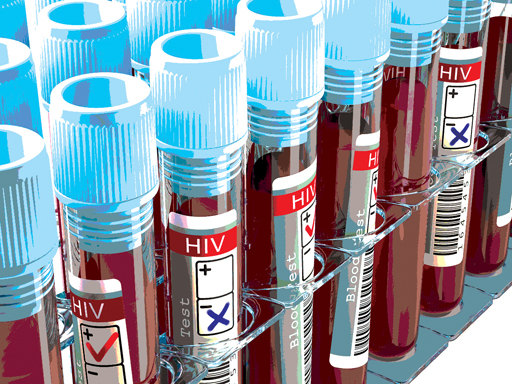HIV: removing the stigma
In Clinical
Follow this topic
Bookmark
Record learning outcomes
Community pharmacies are particularly well-placed to reach difficult-to-access populations with an increased susceptibility to HIV infection €“ so it's time to test.
Learning objectives
After reading this feature you should be able to:
- Recognise the significant problems posed by delayed HIV diagnosis
- Explain the different HIV testing options available
- Identify the key populations that should be targeted with HIV screening.
Of the estimated 103,700 people living with HIV in the UK, approximately 17 per cent (one in every six cases) remain undiagnosed. This means that there are currently around 18,100 people in the UK unaware that they are infected with HIV.1 The group most likely to be affected is men who acquired the virus through heterosexual sex.
Across sexual health clinics in England, HIV testing rates are consistently higher among men who have sex with men (MSM) compared to both heterosexual men and women.1
Undiagnosed HIV presents an important public health issue. Estimates from the US indicate that around half of all new HIV infections occur through transmission from individuals who did not know they were infected.2 Knowledge of HIV status is shown to be associated with a reduction in risk behaviour among patients, so earlier diagnosis is an essential step towards reducing onwards viral transmission rates.2
Late diagnosis of HIV infection can also lead to delays in the initiation of highly active antiretroviral therapy, which may undermine its therapeutic benefits. Currently, around 40 per cent of people diagnosed with HIV in England are already at a late stage of infection (defined as a CD4 count below 350 cells/mm3 within three months of diagnosis).1
Late diagnosis of HIV is associated with increased mortality and morbidity, impaired response to highly active antiretroviral therapy and increased cost to the health service.2 Patients diagnosed late have a 10-fold increased risk of death within one year of their diagnosis compared to those diagnosed promptly.1
Audits carried by the British HIV Association (BHIVA) indicate that around a quarter of deaths among HIV-positive adults are directly attributable to the diagnosis being made too late for effective treatment.2 Late diagnosis is commonest among people who were infected with HIV as a result of injectable drug use but ethnic disparity is also evident.
The proportion of patients diagnosed late is particularly high among black African (58 per cent) followed by other black (45 per cent) and Asian (45 per cent) ethnicities.1 Collectively, these figures make clear the clear need for improved HIV screening and overall sexual health provision.
Testing initiatives and their impact
Several recent initiatives in the UK have attempted to plug the gap in HIV detection and diagnosis by accelerating uptake of testing. Prominent among these is National HIV Testing Week (NHTW), an annual event that aims to encourage testing among the key populations most affected by HIV.3
Co-ordinated by HIV Prevention England, the national HIV prevention programme for England, NHTW takes place in the last week of November to coincide with European HIV Testing Week and exploits publicity opportunities created in the run-up to World AIDS day on December 1. The three major aims of this initiative are to increase:3
- Testing among England's primary populations affected by HIV €“ namely men who have sex with men (MSM) and African peopl
- Awareness and acceptability of HIV testing among these groups
- Access to HIV testing in both community and statutory settings in order to improve early diagnosis and treatment of HIV (and thus reduce onward transmission rates).
All the necessary resources required to get involved and promote the event are supplied. To participate in this year's event contact hivpreventionengland.org.uk.
Another important advance in the availability and accessibility of HIV testing was the launch of the first legally approved HIV self-test kit. Unlike traditional tests, which must be sent off to the laboratory for analysis, this test gives results within just 15 minutes.
The test kit works by detecting antibodies to the HIV virus present in blood. The fingertip is pricked with a lancet and a small droplet of blood applied to the test strip, which is then read by the testing device. Two purple lines appear if the test is positive.
HIV self-tests can be sold through pharmacies, providing teams with the opportunity to offer important advice and counselling on their use. Those customers opting to purchase online should be warned only to choose those kits that meet European testing standards and carry the 'CE' mark for use as a self-test. It is also important to remind customers that free HIV tests are available to access at any time from GPs or sexual health clinics.
An alternative approach is home-sampling kits, where a finger-prick blood or saliva sample is posted to a testing laboratory, which then notifies the customer of their result. Free self-sampling HIV test kits are available in many areas of the country. Customers can find out if they are eligible at test.hiv.
Key facts
- Around 40 per cent of people diagnosed with HIV in England are at a late stage of infection, which increases mortality rate
- Initiatives aimed at increasing HIV screening include National HIV Testing Week
- Pharmacists can encourage uptake of testing, promote prevention, signpost to sources of support and help patients with HIV get the most from their medication
Harnessing pharmacy's role
Public Health England has confirmed that community pharmacy is well-placed to provide a range of sexual and reproductive health services that have typically included emergency hormonal contraception, chlamydia screening and treatment, long-acting reversible contraception (LARC), and level 1 and 2 sexual and reproductive services.4
Expanding this existing remit to incorporate an enhanced role in screening for, and supporting patients with, HIV is a logical next step.
Community pharmacy can play a key role in encouraging uptake of HIV screening both through the sale of licensed HIV self-testing kits and/or provision of in-store HIV screening. The availability of HIV testing in the pharmacy setting is helpful in normalising and removing the associated stigma, which in turn can drive uptake and improve overall diagnosis rates.
A key advantage of in-store testing is that the pharmacist is on hand to explain the result and its implications, provide professional advice and support, and signpost to relevant local services.
Conversely, for pharmacies selling HIV self-testing kits for customers to carry out at home, effective pre-counselling is particularly vital. This should include a detailed discussion of how the person is likely to react to the test result (be it positive or negative), in addition to comprehensive information at the point of sale to ensure customers know how to use the test correctly, and how to interpret and act on the result.
People should also be made aware of the 'window period' when testing, as there can be a time lag of up to three months after infection before current HIV self-tests can detect HIV antibodies in the blood. If time is of the essence, remind customers that alternative tests are available free of charge via sexual health clinics that can detect HIV within one month.

Clearly, not all community pharmacy customers will be targets for HIV screening, so how can teams identify those patients who may benefit from testing? According to the NICE pathway for HIV testing and prevention, the following groups should be routinely recommended and offered HIV screening:5
- Men and women known to be from a country of high HIV prevalence
- Men and women who report sexual contact abroad or in the UK with someone from a country of high HIV prevalence
- Patients who have symptoms that may indicate HIV or where HIV is part of a differential diagnosis
- Patients diagnosed with a sexually transmitted infection
- The sexual partners of men and women known to be HIV positive
- Men who have disclosed that they have sexual contact with other men
- The female sexual contacts of men who have sex with men
- Patients reporting a history of injecting drug use.
Although efforts to encourage uptake of HIV screening should focus on these key target populations, it is important to remember that HIV tests can be recommended to any customer potentially at risk of exposure to the virus. This could include, for example, a person with a new sexual partner who is concerned they may be at risk of infection or someone with multiple sexual partners who is worried they may have become infected in the past.
Community pharmacies are particularly well-placed to reach difficult-to-access populations with increased susceptibility to HIV infection, such as intravenous drug users who may already be familiar with the pharmacy via needle exchange programmes or MSM who currently obtain their condoms from the pharmacy.
As a value added adjunct to HIV screening, it is important that pharmacy teams are equipped to provide advice on risk minimisation behaviours and safe sex practices for the future. Safe sex in the context of HIV prevention relates specifically to practices that prevent the transmission of bodily fluids from one person to another.6
Penetrative sex carries the highest risk of spreading HIV and customers should be encouraged to always use barrier protection in the form of male or female condoms. Body fluids can also be carried on sex toys, so these too should be covered with a fresh condom each time they are used to lower the risk of virus transmission.
Pharmacies can provide condoms to customers who require them and are also able to offer additional sexual health services that may be relevant, such as chlamydia testing, as well as signposting patients to further sources of support.
Signposting is particularly vital for patients testing positive for HIV, who should be referred to their GP or directed to the local sexual health clinic for ongoing support and appropriate treatment.
Case study

A recent case study from Birmingham provides a vivid illustration of the power of pharmacy in promoting high-quality sexual health services in the local area.
In collaboration with Umbrella €“ the sexual health service operated by University Hospitals Birmingham NHS Trust €“ pharmacies across Birmingham have been working hard since August 2015 to drive uptake of free, confidential and accessible pharmacy-led sexual health services. In total, 93 pharmacies have been contracted by Umbrella to deliver sexual health services ranging from STI testing, free condom provision and dispensing of the morning-after pill.
As Jeff Blankley, chairman of the Birmingham LPC, explains: €Pharmacies can offer a wider range of sexual health services than ever before and they feature in most local communities, so we should be encouraging people to use them.€
The ultimate objective of this collaboration is to shift the initial point of contact for appropriate sexual health services from secondary to primary care and motivate more younger customers in the 15-24 year age bracket to visit their pharmacy for treatment and support.
€The fact that pharmacies can offer free, local advice and treatment without the need for an appointment and within more flexible hours will hopefully appeal to younger people who may not choose to make an appointment at a clinic,€ continues Blankley.
The Umbrella initiative provides strong evidence of what community pharmacies can achieve. In Birmingham, partner pharmacies have helped to more than double EHC provision, grow condom distribution through pharmacies nearly six-fold and increase uptake of STI testing kits from just three per month at the start of the initiative to a peak of 76 tests in one month.
Overall, sexual health services provided by pharmacies in one year under the Umbrella scheme totalled well over 9,000, ranging from emergency hormonal contraceptive supply, condom provision and STI testing to chlamydia treatment as well as oral and injectable contraception provision.10
Pre-existing HIV
In addition to accelerating detection and diagnosis of HIV in the community, pharmacy has a pivotal part to play in supporting patients with pre-existing HIV. This role is particularly important given the complex polypharmacy often involved in HIV management and the improved survival of patients, which has lead to co-morbid conditions becoming increasingly common.7
HIV infection is now a chronic condition, expanding the role for community pharmacy in familiar areas such as compliance and medication reviews.
For HIV positive patients at risk of co-morbidities such as hyperlipidaemia, type 2 diabetes or hypertension, pharmacy is well-placed to offer simple initial screening (e.g. through blood pressure measurement or cholesterol checks) that can pick up potential problems early and ensure patients receive appropriate treatment, be it lifestyle or therapeutic intervention.
Identifying and managing these modifiable risk factors is particularly important as people with HIV are at increased risk of developing cardiovascular disease, renal failure, osteoporosis, diabetes and certain cancers due to the combined effect of highly active antiretroviral therapy and disease-induced immunosuppression.8
Six drug classes are now approved for HIV and combination regimens are the current standard of care, making potential drug-drug interactions another important issue in overall HIV management.9 Antiretrovirals may also be subject to sudden changes due to the emergence of resistance €“ so ensuring patients understand what they've been prescribed and why is essential.
Pharmacists can also offer helpful tips on optimal medication usage, such as taking efavirenz on an empty stomach and dosing at bedtime to improve the tolerability of nervous system adverse effects. Counselling HIV patients on medication compliance is another important area, as adherence to a prescribed regimen can have an important impact on clinical outcomes.
The availability of HIV testing in a pharmacy setting is helpful in removing the stigma
References
1. National Aids Trust. Latest UK HIV statistics: nat.org.uk/HIV-in-the-UK/HIV-Statistics/Latest-UK-statistics.aspx
2. British HIV Association (BHIVA). UK National Guidelines for HIV Testing. 2008
3. HIV Prevention England. National HIV Testing Week: hivpreventionengland.org.uk
4.Public Health England. HIV, sexual and reproductive health: current issues bulletin. December 2013
5. NICE. NICE Pathway: HIV Testing and prevention.
6. Terrence Higgins Trust. Safer sex and HIV: tht.org.uk/sexual-health/Improving-your-sexual-health/Safer-sex-and-HIV
7. Swaden L. The role of the HIV pharmacist in managing complex polypharmacy has never been more important. The Pharmaceutical Journal. January 2011
8. J Wick. New guidelines list three ways pharmacists can help HIV patients.
Pharmacy Times. March 2016

